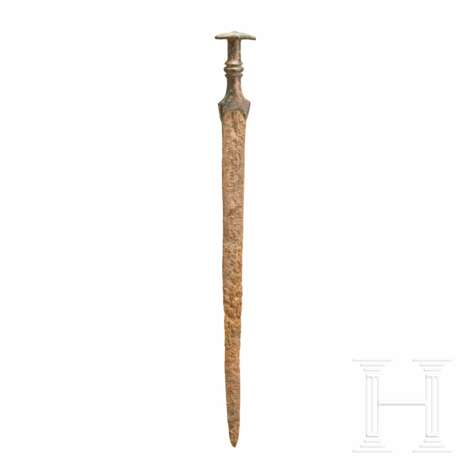ID 1198529
Lot 6 | Eisenschwert mit Bronzegriff, hethitisch, 14. - 13. Jhdt. v. Chr.
Schmale, spitz zulaufende Eisenklinge mit längsprofilierter Mittelrippe, die unmittelbar vor dem Griff minimal ausschwingt. Die Klinge mit Angel oben im Überfangguss mit einem bronzenen Griff versehen, der mittig drei Rippen besitzt: eine wulstige in der Mitte und zwei gratige darüber und darunter. Letztere auf dem Grat fein gekerbt. Flacher, aber massiver Knauf, in Aufsicht von oben ein "flach gedrücktes" Sechseck mit abgerundeten Ecken. Die Längskanten des Knaufs mittig über der Handhabe mit je einem Knuppel versehen. Unterhalb der Handhabe besitzt die Griffplatte seitlich nach unten ausgezogene Zargen, welche die Klinge seitlich einfassen, deren oberes Ende somit bögenförmig eingeschlossen ist. Länge 56 cm. Breite der Klinge im oberen Bereich ca. 3,3 cm. Breite des Knaufs in Aufsicht 5,5 cm. Die Eisenklinge mit Korrosionsschicht bedeckt und abgesehen von minimalen Ausbrüchen am Rand ausgezeichnet erhalten. Der Bronzegriff mit minimalen Korrosionsnarben und Oxydauflagen.
Eine sehr nahe Parallele zu dem hier vorgestellten Stück befindet sich im Ruhr Museum Essen. Äußerst seltenes und frühes Eisenschwert, das zum Zeitpunkt seiner Herstellung eine technologische Innovation darstellte.
Eine metallurgische Messung des Eisens erbrachte folgende Beimischungen in der Eisenlegierung: 1,2 % Mangan, 1 % Kobald (typisch für anatolische Lagerstätten), 4,5 % Kupfer (der hohe Anteil rührt wohl von einer Verunreinigung der Patina durch Oxyde des Bronzegriffs her), 0,1 % Zinn und vier weitere Elemente. Die Bronzelegierung des Griffs ist zweifelsohne antik und typisch für sehr alte Lagerstätten, die in römischer Zeit bereits ausgebeutet waren. Die Messung erbrachte u.a. folgende Ergebnisse: 76 % Cu, 17 % Zinn, 1,3 % Blei, 0,8 % Ag, 0,36 % Gold.
Provenienz: Süddeutsche Privatsammlung, erworben in den 80er Jahren im süddeutschen Kunsthandel.
A Hittite iron sword with bronze handle, 14th - 13th century B.C.
A Hittite iron sword with bronze handle, 14th - 13th century B.C.
Narrow, tapered iron blade with a longitudinally profiled central rib that swings out slightly immediately in front of the handle. The blade with a tang at the top with a bronze handle that has three ribs in the middle: a bulging one in the middle and two ridged ones above and below. The latter finely notched on the ridge. Flat, but solid pommel, viewed from above a "flattened" hexagon with rounded corners. The long edges of the knob are each provided with a club in the middle above the handle. Below the handle, the handle plate has frames that extend laterally downwards, which enclose the blade on the side, the upper end of which is thus enclosed in an arch. Length 56 cm. Width of the blade in the upper area approx. 3.3 cm. Width of the knob when viewed from above 5.5 cm. The iron blade is covered with a layer of corrosion and is in excellent condition apart from minimal chips on the edge. The bronze handle with minimal corrosion scars and oxide coatings.
A very close parallel to the piece presented here can be found in the Ruhr Museum Essen. Extremely rare and early iron sword that represented a technological innovation at the time of its manufacture.
A metallurgical measurement of the iron revealed the following admixtures in the iron alloy: 1.2% manganese, 1% cobalt (typical of Anatolian deposits), 4.5% copper (the high proportion probably comes from contamination of the patina by oxides from the bronze handle), 0.1% tin, and four other elements. The bronze alloy of the handle is undoubtedly ancient and typical of very old deposits that were already exploited in Roman times. The measurement revealed, among other things, the following results: 76% Cu, 17% tin, 1.3% lead, 0.8% Ag, 0.36% gold.
Provenance: South German private collection, acquired in the South German art trade in the 80s.
Condition: I - II
| Auction house category: | Egypt and Asia |
|---|
| Auction house category: | Egypt and Asia |
|---|
| Address of auction |
Hermann Historica Bretonischer Ring 3 85630 Grasbrunn / München Germany | ||||||||||||||
|---|---|---|---|---|---|---|---|---|---|---|---|---|---|---|---|
| Preview | |||||||||||||||
| Phone | +49 (0)89 5472 649 0 | ||||||||||||||
| Fax | +49 (0)89 5472 64999 | ||||||||||||||
| Buyer Premium | 25 % | ||||||||||||||
| Conditions of purchase | Conditions of purchase | ||||||||||||||
| Business hours | Business hours
|



